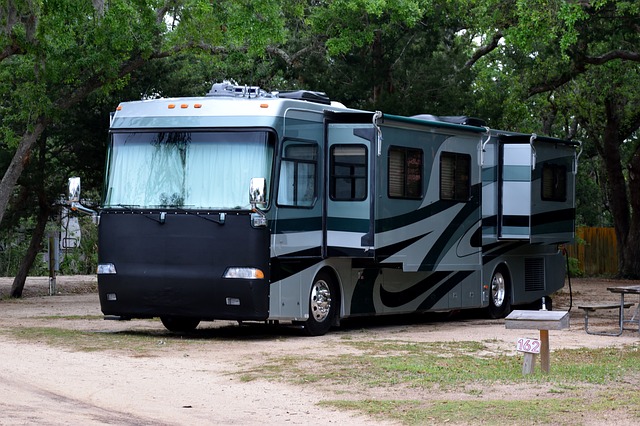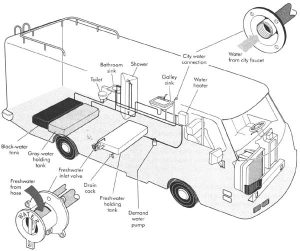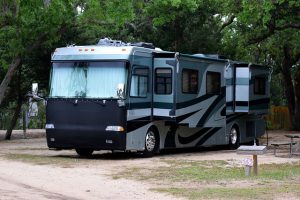

Of all the advantages and comforts RVing provides over other kinds of camping, indoor plumbing has to be one of the greatest. Having to get out of a warm tent in the middle of the night to visit the outhouse is, assuredly, very unpleasant. You also have water ready-at-hand for cooking and cleaning…and for a good, hot shower after a busy (or not so busy) day. RV plumbing is really one of the best parts of having your home on wheels. So it’s a good idea to know a little bit about it.
Your RV plumbing setup
The easiest way to explain your plumbing system is perhaps to show you. Take a look at this diagram of all the plumbing systems in your RV.
Although there is a lot going on here, if you look closely, the RV plumbing parts are all pretty simple. Fresh water comes into the rig via the freshwater intake valve and fills the freshwater holding tank. From there, it gets pumped by a 12v RV water pump into the plumbing system. The water pump is responsible for your water pressure, and for keeping water running through your motorhome. Many RVers appreciate having an on-demand water pump, which you can keep turned on but only runs when the system needs pressure. Once there’s enough water pumped from the freshwater tank to the pipes to provide pressure, it stops running.
RV plumbing fixtures
Once the water system is pressurized, thanks to your water pump, you can now get running water through all of your plumbing fixtures. Your sinks, indoor shower, outdoor shower, ice maker all run thanks to the water pump.

RV toilet plumbing
You also need water to flush. Water that’s flushed down the toilet goes into your black water tank, while clean water replaces it in the bowl. The clean water keeps the gasket, which seals the valve, lubricated so it maintains a good seal. It also keeps unpleasant smells at bay.
RV water tanks
Your RV has three different tanks for water. The freshwater tank, which we’ve discussed, is filled with clean, fresh water. The black water tank is where waste is kept when you flush the toilet. The gray water tank holds all the water from other drains in your RV – your shower and sinks. The gray and black water tanks each have an RV plumbing vent – a pipe that runs upward from the top to vent out the roof of your RV. This helps keeps smells from permeating your motorhome, as they’re released into the air instead.
RV water heaters
Your RV water heater is responsible for making sure you have hot water when you need it. They’re typically 6-gallon or 10-gallon tanks, plumbed as part of the RV plumbing system. Cold water enters from the freshwater tank, via a tube at the bottom, and fills the tank which pressurizes the hot water. When the water heater tank is full, the water heater uses propane or electricity to heat the water. When you turn on the hot water valve on your sink or shower, the RV plumbing system pulls water directly from the water heater tank. As you use it, the water pump senses the loss of pressure and pumps more cold water in through the tube to the bottom of the hot water tank. Your water heater has a sensor to keep track of the temperature of water in the tank, and if it drops below a certain temp, the water heater will turn itself back on to heat the water.
While leaving the water tank on all the time means you’ll have hot water whenever you need it, it also uses power each time it heats up water. It’s a good idea to turn off the water heater at night, or for periods of time when you won’t need hot water. When you turn it back on, your water should heat up in about 5-10 minutes.
RV plumbing parts
RV plumbing systems usually use some type of plastic tubing. Your RV likely includes either ABS pipe or PEX tubing to deliver the water to your RV plumbing fixtures. PEX tubing is becoming more popular today, so if your RV was made in the last 10 years, that’s probably what you have. It’s lightweight and more flexible than metal or ABS pipe.
There are also several types of RV plumbing fittings that are used to turn water on and off, to connect tubing around corners, and to connect tubing to other fixtures. It’s a good idea to bring along different sizes of tubing and/or pipe that your RV uses in case you need to make any repairs. Also, it’s handy to have some of the RV plumbing fittings most commonly used in your RV with you in case you need them. Because RV plumbing fixtures are the same as those used in homes and elsewhere, you should be able to find them not only at an RV service center, but also at any hardware store.
Understanding your RV plumbing means you’ll be better prepared to make sure it’s working properly and that your trip will be pleasant and comfortable. Happy trails!
This post may contain affiliate links.
